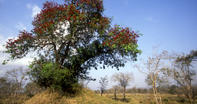
Name
Weeping boer bean (Schotia brachypetala).Other Names
Huilboerboon, tree fuchsia and African walnutDescription
The flowers of the weeping boer bean have vividly coloured sepals, stamens and stalks, which overflow with dripping nectar. This suggests the origin of its common name weeping boer tree, named huilboerboon in Afrikaans.
The weeping boer bean is a medium-sized to large tree, varying in height from 11 m to 16 m and able to reach 22 m. It has a single trunk which grows its first branches rather close to the ground. The tree is densely branched and has a round, wide-spanning top. Its leaves are compound, comprised of four to six leaflets.
The leaves have curvy edges, a reddish-copper colour when new and maturing to a bright green, and then a shiny dark green. The bark of the tree has a rough texture and is brown to grey-brown in colour. In areas of no frost, the weeping boer bean is evergreen. In colder areas, it is deciduous and loses its leaves from winter to spring.
Weeping Boer Bean Flowers
The weeping boer bean blooms during the South African spring, in the months of August to November, although its flowering time is rather sporadic as one weeping boer bean may bloom next to another with no flowers. This affects the birds, which feed on the flowers but results in a prolonged feeding season. The flowers are bright, deep red in colour and grow in bunches in the dense tree tops on old wood.Weeping Boer Bean Fruit
This tree carries fruit in the form of a pod – hard, flat, dark brown and woody. The pods hold flat, light brown seeds with yellow arils, measuring 20 mm in diameter. These pods mature in the summer to autumn months – February to May – and split open while hanging on the tree.Weeping Boer Bean Uses
The weeping boer bean tree top is active and noisy during its flowering period, attracting various birds, insects and animals. Nectar-feeding birds such as sunbirds, insects and bees feed on the flowers’ nectar, and insect-eating birds are attracted by these nectar-loving insects.
Monkeys, baboons and starlings feed on the flowers, monkeys eat the seeds in the pods and birds the aril of the seeds. The leaves are browsed by game. In game reserves, one will find the black rhino feeding on the bark of the weeping boer bean. This tree is used in various ways to treat ailments.
A mixture of its root and bark is made to treat nervous heart conditions, stomach problems, and to purify the blood. A decoction is also made of the bark as a remedy to heartburn and hangovers. Roasted weeping boer bean seeds can be eaten. It has a high carbohydrate content and is low in fat and protein.
Early European settlers and Bantu speaking people learned to roast mature pods and eat the seeds from the Khoikhoi. The bark is used for dyeing, creating reddish-brown to red colours. The heartwood is resistant to termites, hard, heavy and a dark walnut colour.
Its dense and fine texture makes this wood a good fit for furniture and flooring blocks. It is said to have been popularly used as wagon beams and other parts of the wagon. The sapwood is only durable if treated and is a pinkish-grey.